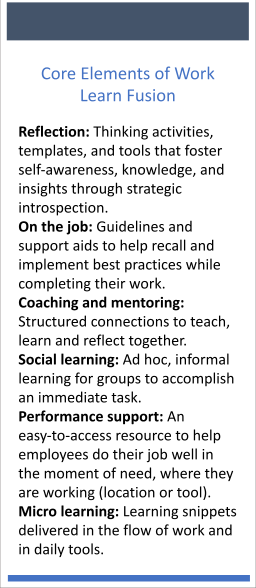Becoming a skills-based organization, like any major corporate strategy shift, is a journey. Accenture has been on this challenging, rewarding journey for nearly a decade. Investing in skills as our common currency has transformed our responsiveness to business needs as well as evolving talent aspirations. Being skills-driven also helps us achieve our talent strategy: To access and create talent and unlock people’s potential, for example by hiring for skills and potential vs. university degrees, to expand our talent pool.
Our journey began in earnest in 2014, when we needed to rapidly build specialization in new, emerging areas to achieve our goal of becoming the leading digital services provider. We developed a new taxonomy and digital library of 8,000-plus skills reflecting dynamic business needs and labor markets, creating a single source of truth on skills to use across the entire enterprise. Then, we built proprietary algorithms to calculate skills and proficiencies, including “proximity” skills — similar skills obtainable with relatively minimal skilling.
Within 12 months, algorithms generated skill assessments that our people validated as more than 93 percent accurate. This machine-inferred, human-confirmed data was better, more reliable and available in real-time, to ensure right skills, right place, right time and the foundation to become a skills-based company. The data and insights from that platform and others that followed are game changers.
Skills-driven organization:
An integrated network of human + technology systems where skills are the currency and skill-based practices unlock opportunities for all while maximizing talent potential for the organization.
Today, we continue to use algorithms to assess both project needs and career prospects, assisting with staffing assignments, role opportunities and more. Our people can acquire skills based on their work experience and through certifications and learning opportunities; in turn, their skills data enables us to flexibly respond to shifting client needs while also recommending skill-specific training and opportunities that align with an individual’s interests. This approach exemplifies how the right technology and agreement on priorities can enable HR to seamlessly partner with the business and deliver true strategic impact.
Applying the science of learning to work
Emerging technology has always prompted us to think differently about skilling at scale, and change is only going to happen faster as the transformative power of artificial intelligence and generative AI continues to unfold. According to recent Accenture research, “A new era of generative AI for everyone,” 40 percent of working hours across all industries can be impacted by large language models like ChatGPT, through augmentation and automation.
We were already shifting our skilling focus before ChatGPT’s arrival in November 2022: To the flow of work, using the science of learning. Though we can never truly be future-proof, we can be more ready by applying what we’ve learned from years of investment in understanding neuroscience, behavioral psychology, social physics, and more, and how they impact learning outcomes. Based on these insights, we have created models and techniques to make learning more efficient and effective.
To help improve our formal learning, eight “Durable Learning Principles” guide course design so learning lasts, by being Relevant, Engaging, Contextual, Effortful, Generative, Social, Spaced and — critically important — involving Practice. We also enhance our people’s ability to gain and retain knowledge with “Learn to Learn” resources that teach individuals the science behind, and optimization of, intake, encoding and retrieving information. These tips became our popular Brain Hacks video series.
Work Learn Fusion
Now, we are systematically applying the science of learning not just to learning, but also to work, striving to build relevant skills better and faster through what we call “Work Learn Fusion”: increasing learning application within formal training, and reimagining how work can maximize learning and performance every day. This is essential to serving our clients, and to enabling our people to grow vibrant careers.

First, we’re shifting the overall focus of our learning solutions from objectives to be learned to tasks to be performed. That focus helps keep skills and job performance — and not just knowledge — front and center. Second, we’re integrating six elements that we know enhance lasting learning through application into formal learning and the flow of work: Reflection, On-the-job, coaching and mentoring, social learning, performance support and micro-learning (see details in Figure 1).
Third, we are focusing on helping people take advantage of every opportunity to intentionally learn as they work, a critical mindset shift that can significantly increase learning speed and retention, supported by technology enhancements making it easier than ever to find the learning our people need, when they need it.
Finally — and this was not obvious to us at the outset — we are raising the focus on the qualities of people leadership to include building learners and a learning culture and making it a strategic priority. This is the most significant lever to closing skills gaps.
One last thought
Becoming truly skills-driven involves so many moving parts — taxonomy, tools, integration, adoption — that it can be easy to get lost in the mechanics. That’s why it’s essential to clearly understand the business problems you most need to solve through a skills-based approach. Defining a strong vision and strategy informed by this understanding, coupled with an uncompromising commitment to a learning culture, helps realize true value from skills and skills data as a powerful enabler of business and talent.















